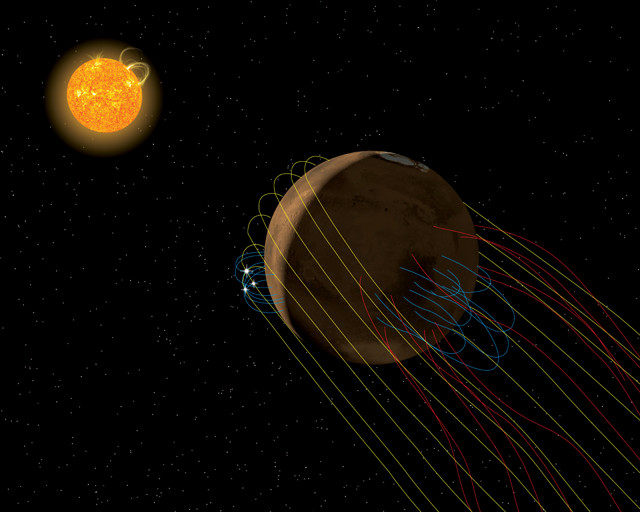
by Timothy Oleson Friday, January 12, 2018

An artist's depiction of solar magnetic field lines (yellow), localized Martian field lines (blue) and magnetic reconnected field lines (red) all contributing to Mars' complex magnetotail. Credit: Anil Rao/Univ. of Colorado/MAVEN/NASA.
With two rovers patrolling the surface of Mars, six spacecraft orbiting above it, and scientists here on Earth studying the Red Planet from afar, new findings are announced often. Here are a few of the latest updates.
Long dark streaks that appear and fade annually on Martian slopes have previously been suggested as evidence that liquid water occasionally flows on the planet’s surface, but new research douses that notion, instead suggesting the features reflect dry sediment flows. The streaks, known as recurring slope lineae (RSL), form during warm seasons on steep slopes in Mars’ midlatitudes and near its equator. Their seasonality and dark coloration, as well as other aspects of their appearance and their observed association with perchlorate salts, have been taken as signs that RSL form as a result of flowing liquid water, but direct evidence of such water has not been seen. In the new study, Colin Dundas of the U.S. Geological Survey in Flagstaff, Ariz., and colleagues studied high-resolution imagery of 151 RSL at 10 different sites. They found that in almost every case, regardless of elevation or RSL length, the flows ended when they encountered slopes inclined between 28 and 35 degrees, a range that matches observed angles of repose for sandy sediments on both Martian and terrestrial dunes. If liquid water were involved, the researchers noted, there’s no reason it shouldn’t continue flowing onto less steep slopes. “Flowing liquid water in the current Martian climate has always been an extraordinary claim,” the team wrote in Nature Geoscience. This work suggests “that RSL are no longer extraordinary evidence.”
Scientific consensus holds that Mars was warm and wet early in its history, during a time known as the Noachian, and that after this period ended about 3.7 billion years ago, the planet transitioned toward cold and dry conditions. But geologic evidence from Martian sedimentary deposits dating to the Hesperian, which immediately followed the Noachian, suggests the planet still occasionally warmed enough for short-lived lakes to form. In a new study in Nature Geoscience, Edwin Kite of the University of Chicago and colleagues show that bursts of methane into the atmosphere could explain the temporary warm-ups. By modeling past climatic conditions on Mars, the scientists found that shifts in the planet’s axial tilt, which change the amount of sunlight that hits different parts of the planet, could have destabilized ice-trapped methane, allowing it to escape into the atmosphere and trap heat. The methane would eventually break down, however, limiting the intermittent warm episode to less than a million years and allowing the prevailing arid and cold climate to return.
Data from NASA’s MAVEN spacecraft show that the planet has a twisted magnetic tail, or magnetotail, unlike those of Venus or Earth. Magnetic tails form — and take on different shapes — as magnetic fields embedded in the solar wind stream past and interact with objects in the solar system. Whereas Venus has no magnetic field of its own and Earth has an encompassing, internally generated magnetic field, Mars has separate, localized fields that emanate from certain parts of the planet. These fields sometimes combine with magnetic fields in the solar wind in a process called magnetic reconnection. Researchers predicted that magnetic reconnection would “cause the Martian magnetotail to twist 45 degrees from what’s expected based on the direction of the magnetic field carried by the solar wind,” said Gina DiBraccio of NASA’s Goddard Space Flight Center in Greenbelt, Md., in a statement. “When we compared those predictions to MAVEN data on the directions of the Martian and solar wind magnetic fields, they were in very good agreement.” DiBraccio presented the work in October at the annual meeting of the American Astronomical Society’s Division for Planetary Sciences in Provo, Utah. Energy released during magnetic reconnections could contribute to the long-term loss of Mars’ extremely thin upper atmosphere, another process that MAVEN’s data are being used to study.
© 2008-2021. All rights reserved. Any copying, redistribution or retransmission of any of the contents of this service without the expressed written permission of the American Geosciences Institute is expressly prohibited. Click here for all copyright requests.